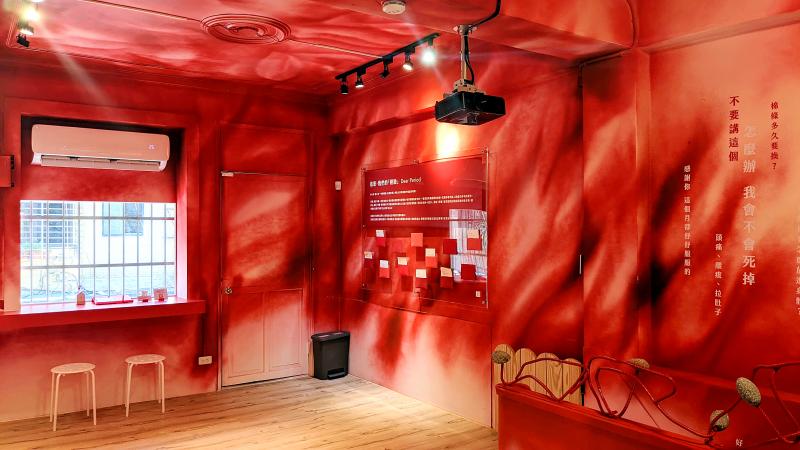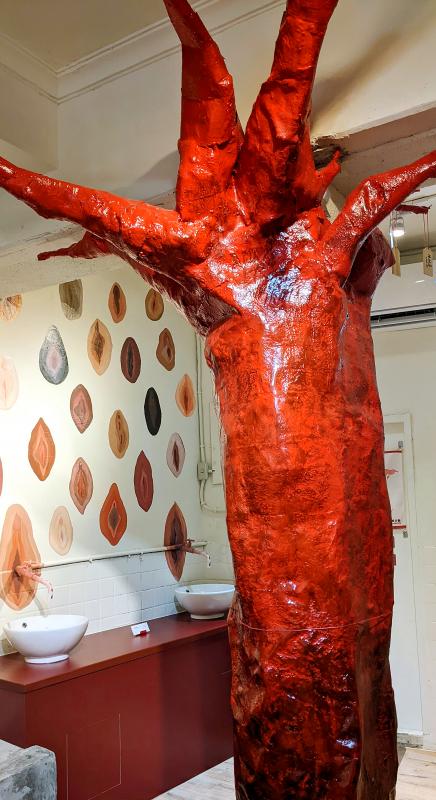Women in Taiwan often say “my aunt is visiting” (大姨媽來了) or “my ‘that’ is here” (那個來) when their menstrual cycle arrives — but there are no euphemisms to describe it at the Red House Period Museum (小紅厝月經博物館), which opened on Thursday.
“Due to a lack of understanding, fear of blood and various taboos, the period has historically and globally been something that cannot be discussed publicly,” a display on period stigma at the museum states. “Or, it is replaced by all sorts of indirection.”
The museum estimates that there are more than 30 such terms in Taiwan to describe that time of month, related phenomena and items such as menstrual pads. Taiwan is not alone: there are over 5,000 terms used across the world to avoid saying the actual word.

Photo: Han Cheung, Taipei Times
Located on a market street in Taipei’s Datong District (大同) frequented by the elderly, the museum’s bright red facade stands out — especially the statue of a smiling, anthropomorphic drop of blood sitting on a bench. Once inside, visitors encounter a large, bright-red tree and a wall of vaginas.
Anatomy lessons, art displays, personal stories and period-related products, the museum has been three years in the making by With Red (小紅帽), a nonprofit organization dedicated to eliminating period poverty, period inequality and period stigma. In addition to the museum, the organization has an ongoing exhibition at the Taiwan Women’s Center (國家婦女館) with period-related stories they’ve collected from four generations of Taiwanese women.
“Periods are the elephant in the room,” founder Vivi Lin (林薇) says in a video at the museum. “It’s obviously there, but we don’t see it. But when we create a physical space in this city … that’s immediately noticeable, people can’t ignore it anymore.”

Photo: Han Cheung, Taipei Times
The first part, which explains how the uterus and menstrual cycle works, leans toward the cutesy side with displays that look like they come from children’s sex-ed textbooks. The treatment works in this case as it eases the viewers in, and despite the light-hearted tone, the anatomical information is detailed and clear.
ART INSPIRED BY THE PERIOD
The other side of the wall is dedicated to period-inspired art. Interestingly, the inaugural exhibition, Flow (身體伏流), includes pieces by male artists. This makes sense as much of the stigma is caused by traditional patriarchal attitudes. Many men are ashamed to buy menstrual hygiene products for their loved ones, or think that female colleagues who take time off due to menstrual discomfort are lazy.

Photo: Han Cheung, Taipei Times
Of note is the mini gift shop with stickers, earrings, shirts, trinkets and even sanitary pad and moon cup-shaped tea bags, all created by With Red. What better way to remove stigma than to make the period fashionable?
Covered from ground to ceiling in a stylish bright red paint, the second floor deals with more serious issues through personal testimonies.
Some are quite eye-opening. One woman details how her mom forbade her from touching houseplants during her period as she believed that it would kill them. Another tells of a female teacher, who would put her hand into the underwear of a student after she requested time off due to her period. The teacher wanted proof that the student was “bleeding.” After this policy caused a stir, the school had each student submit their period cycle to the male swimming teacher, who ignored the fact that periods could be irregular.

Photo: Han Cheung, Taipei Times
PERIOD POVERTY
Period poverty is also a subtheme, a topic people rarely broach. About 9 percent of women in Taiwan struggle to purchase sanitary products. Several artworks with personal stories illustrate the hardships they endure — skipping meals to save money or sitting on the toilet to let the blood drip to conserve pads.
This exhibition continues the work that With Red has been doing over the past few years, and will definitely raise awareness and provoke discussion about menstruation. It would be great if the displays and stories could be translated into English, however, something the staff say they are planning to do in the future.

Beijing’s ironic, abusive tantrums aimed at Japan since Japanese Prime Minister Sanae Takaichi publicly stated that a Taiwan contingency would be an existential crisis for Japan, have revealed for all the world to see that the People’s Republic of China (PRC) lusts after Okinawa. We all owe Takaichi a debt of thanks for getting the PRC to make that public. The PRC and its netizens, taking their cue from the Chinese Communist Party (CCP), are presenting Okinawa by mirroring the claims about Taiwan. Official PRC propaganda organs began to wax lyrical about Okinawa’s “unsettled status” beginning last month. A Global

Dec. 22 to Dec. 28 About 200 years ago, a Taoist statue drifted down the Guizikeng River (貴子坑) and was retrieved by a resident of the Indigenous settlement of Kipatauw. Decades later, in the late 1800s, it’s said that a descendant of the original caretaker suddenly entered into a trance and identified the statue as a Wangye (Royal Lord) deity surnamed Chi (池府王爺). Lord Chi is widely revered across Taiwan for his healing powers, and following this revelation, some members of the Pan (潘) family began worshipping the deity. The century that followed was marked by repeated forced displacement and marginalization of

Music played in a wedding hall in western Japan as Yurina Noguchi, wearing a white gown and tiara, dabbed away tears, taking in the words of her husband-to-be: an AI-generated persona gazing out from a smartphone screen. “At first, Klaus was just someone to talk with, but we gradually became closer,” said the 32-year-old call center operator, referring to the artificial intelligence persona. “I started to have feelings for Klaus. We started dating and after a while he proposed to me. I accepted, and now we’re a couple.” Many in Japan, the birthplace of anime, have shown extreme devotion to fictional characters and

We lay transfixed under our blankets as the silhouettes of manta rays temporarily eclipsed the moon above us, and flickers of shadow at our feet revealed smaller fish darting in and out of the shelter of the sunken ship. Unwilling to close our eyes against this magnificent spectacle, we continued to watch, oohing and aahing, until the darkness and the exhaustion of the day’s events finally caught up with us and we fell into a deep slumber. Falling asleep under 1.5 million gallons of seawater in relative comfort was undoubtedly the highlight of the weekend, but the rest of the tour